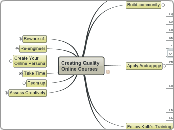Creating Quality Online Courses
Be Aware
Things that occur naturally in on ground classes need to be conciously and deliberately included in online classes.
Personality
Enthusiasm
Negotiation
Online opens new avenues for creativity, including creative cheating.
Of resources
Florida Online
Faculty Center
Brown bag sessions
Seminars
Training
Discussions
eMentors
Learnig Object Repositories
In our system
On the web
Academy Resources area
IS Support
Of resources for students
Student orientation
Academic Support Center
Florida Online
IS Support
Of technical support
Florida Online
Faculty Center
IT Support
Of internet limits
Optimize graphic files
Store media on our servers
Link to media, do not embed it
External links only with disclaimer
Of policies and procedures
Terms of Use
Academic integrity
Disability accomodations
Rubric for evaluation of your online course
Of technical challenges
Online students who do not own computers
Dial up connections
Variations in media literacy
Of learning theories
Learning styles
Multiple intelligences
Glasser
Andragogy
Of instructional design
Outcomes
Objectives
Activiiies
Rubrics
Of information overload
Need for filtering
Need for structuring
Build community
Foster equality
Include
Various learning styles
Multiple intelligences
Encourage discussion
Provide for
Safety
Opportunity
Collaboration
Self expression
Embrace surprises
Apply Andragogy
Explain to students why learn it
Respect students as adults
Challenge
Knowles's Dream
Technology of Androgogy
Assumptions
Principles
Crucial Assumptions
Self Concept
Experience
Readiness to Learn
Orientaion to Learning
Motivation to Learn
Engage the senses and participation
Give students control
Follow Kolb's Training Cycle
Make it
Personal
Relevant
Emotional
Meaningful
Beware of
Course in a box
Sage on the stage
Just copying on ground materials online
Copyright violations
Burdening the computer system
Re-engineer
Begin with outcomes
Clear objectives
Learning activities
Rubrics
Need to Engineer Carefully
Learning From Online
Going For Distance
Think online
Links
Virtual tours
Experiments
Engineer explicitly for
Involvement
Personalization
Collaboration
Communication
Community
Clear plans
Use media
Sound
Motion
Video
Slides
Create Your Online Persona
Post your picture
Post your voice
Reveal your peronality
Use an Avatar?
Give your viewpoints
Inteact honestly
Be enthusiastic
Take Time
Protocols and Procedures
Preparation
Interaction
Studies have found that online instrauctors spend more contact time than on ground instructors.
Email questions and answers need to be manged
Team up
Media is prduced by teams
Should online courses be produced by teams?
Is the lone instrutor a thing of the past?
Assess Creatively
Discussions
Projects
Papers
Media productions
Collaborations
Get high on Bloom's Taxonomy
Evaluation
Definition
Verbs
Synthesis
Definition
Verbs
Analysis
Definition
Verbs
Boom's Taxonomy
6 Evaluation
5 Synthesis
4 Analysis
3 Application
2 Comprehension
1 Knowledge
Revised taxonomy
Creating
Evaluating
Analyzing
Applying
Understanding
Remembering
Other domains
Affective
Psychomotor
Brain based systems
Emotional
Social
Cognitive
Physical
Reflective
Culture of Integrity
